| Listing 1 - 8 of 8 |
Sort by
|
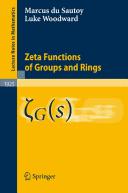
ISBN: 3540747761 354074701X 9783540747017 9783540747765 Year: 2008 Publisher: Berlin, Heidelberg Springer-Verlag Berlin Heidelberg
Abstract | Keywords | Export | Availability | Bookmark
 Loading...
Loading...Choose an application
- Reference Manager
- EndNote
- RefWorks (Direct export to RefWorks)
Zeta functions have been a powerful tool in mathematics over the last two centuries. This book considers a new class of non-commutative zeta functions which encode the structure of the subgroup lattice in infinite groups. The book explores the analytic behaviour of these functions together with an investigation of functional equations. Many important examples of zeta functions are calculated and recorded providing an important data base of explicit examples and methods for calculation.
Group theory. --- Functions, Zeta. --- Rings (Algebra) --- Noncommutative algebras. --- Groups, Theory of --- Substitutions (Mathematics) --- Algebra --- Algebras, Noncommutative --- Non-commutative algebras --- Algebraic rings --- Ring theory --- Algebraic fields --- Zeta functions --- Rings (Algebra). --- Number theory. --- Algebra. --- Group Theory and Generalizations. --- Number Theory. --- Non-associative Rings and Algebras. --- Mathematics --- Mathematical analysis --- Number study --- Numbers, Theory of --- Functions, Zeta --- Group theory --- Noncommutative algebras --- 512.54 --- 512.54 Groups. Group theory --- Groups. Group theory --- Nonassociative rings.
Book
ISBN: 3540697985 3540697977 Year: 2008 Publisher: Berlin, Heidelberg : Springer Berlin Heidelberg : Imprint: Springer,
Abstract | Keywords | Export | Availability | Bookmark
 Loading...
Loading...Choose an application
- Reference Manager
- EndNote
- RefWorks (Direct export to RefWorks)
In the last decade, convolution operators of matrix functions have received unusual attention due to their diverse applications. This monograph presents some new developments in the spectral theory of these operators. The setting is the Lp spaces of matrix-valued functions on locally compact groups. The focus is on the spectra and eigenspaces of convolution operators on these spaces, defined by matrix-valued measures. Among various spectral results, the L2-spectrum of such an operator is completely determined and as an application, the spectrum of a discrete Laplacian on a homogeneous graph is computed using this result. The contractivity properties of matrix convolution semigroups are studied and applications to harmonic functions on Lie groups and Riemannian symmetric spaces are discussed. An interesting feature is the presence of Jordan algebraic structures in matrix-harmonic functions.
Matrix groups. --- Convolutions (Mathematics) --- Convolution transforms --- Transformations, Convolution --- Distribution (Probability theory) --- Functions --- Integrals --- Transformations (Mathematics) --- Group theory --- Matrices --- Functions of complex variables. --- Global differential geometry. --- Functional analysis. --- Operator theory. --- Harmonic analysis. --- Algebra. --- Functions of a Complex Variable. --- Differential Geometry. --- Functional Analysis. --- Operator Theory. --- Abstract Harmonic Analysis. --- Non-associative Rings and Algebras. --- Mathematics --- Mathematical analysis --- Analysis (Mathematics) --- Functions, Potential --- Potential functions --- Banach algebras --- Calculus --- Bessel functions --- Fourier series --- Harmonic functions --- Time-series analysis --- Functional analysis --- Functional calculus --- Calculus of variations --- Functional equations --- Integral equations --- Geometry, Differential --- Complex variables --- Elliptic functions --- Functions of real variables --- Differential geometry. --- Nonassociative rings. --- Rings (Algebra). --- Algebraic rings --- Ring theory --- Algebraic fields --- Rings (Algebra) --- Differential geometry
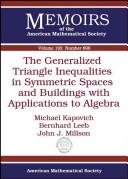
ISBN: 9780821840542 Year: 2008 Publisher: Providence, R.I. American Mathematical Society
Abstract | Keywords | Export | Availability | Bookmark
 Loading...
Loading...Choose an application
- Reference Manager
- EndNote
- RefWorks (Direct export to RefWorks)
Algebra --- 51 <082.1> --- Mathematics--Series --- Semisimple Lie groups --- Linear algebraic groups --- Geometric group theory --- Lorentz groups --- Symmetric spaces --- Rings (Algebra) --- Groupes de Lie semi-simples --- Groupes algébriques linéaires --- Groupes, Théorie géométrique des --- Lorentz, Groupes de --- Espaces symétriques --- Anneaux (algèbre) --- Spaces, Symmetric --- Geometry, Differential --- Semi-simple Lie groups --- Lie groups --- Algebraic rings --- Ring theory --- Algebraic fields --- Algebraic groups, Linear --- Geometry, Algebraic --- Group theory --- Algebraic varieties --- Groups, Lorentz --- Continuous groups --- Groupes de Lie semi-simples. --- Groupes algébriques linéaires. --- Groupes, Théorie géométrique des. --- Lorentz, Groupes de. --- Espaces symétriques.
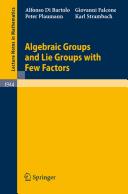
ISBN: 9783540785835 3540785833 3540785841 Year: 2008 Publisher: Berlin : Springer,
Abstract | Keywords | Export | Availability | Bookmark
 Loading...
Loading...Choose an application
- Reference Manager
- EndNote
- RefWorks (Direct export to RefWorks)
Algebraic groups are treated in this volume from a group theoretical point of view and the obtained results are compared with the analogous issues in the theory of Lie groups. The main body of the text is devoted to a classification of algebraic groups and Lie groups having only few subgroups or few factor groups of different type. In particular, the diversity of the nature of algebraic groups over fields of positive characteristic and over fields of characteristic zero is emphasized. This is revealed by the plethora of three-dimensional unipotent algebraic groups over a perfect field of positive characteristic, as well as, by many concrete examples which cover an area systematically. In the final section, algebraic groups and Lie groups having many closed normal subgroups are determined.
Linear algebraic groups. --- Lie groups. --- Group theory. --- Groupes linéaires algébriques --- Groupes de Lie --- Groupes, Théorie des --- Linear algebraic groups --- Lie groups --- Group theory --- Geometry --- Algebra --- Mathematical Theory --- Mathematics --- Physical Sciences & Mathematics --- Théorie des groupes --- Groups, Theory of --- Substitutions (Mathematics) --- Groups, Lie --- Algebraic groups, Linear --- Mathematics. --- Algebraic geometry. --- Nonassociative rings. --- Rings (Algebra). --- Topological groups. --- Group Theory and Generalizations. --- Algebraic Geometry. --- Topological Groups, Lie Groups. --- Non-associative Rings and Algebras. --- Lie algebras --- Symmetric spaces --- Topological groups --- Groups, Topological --- Continuous groups --- Algebraic rings --- Ring theory --- Algebraic fields --- Rings (Algebra) --- Algebraic geometry --- Math --- Science --- Geometry, Algebraic --- Algebraic varieties --- Geometry, algebraic. --- Topological Groups. --- Algebra. --- Mathematical analysis
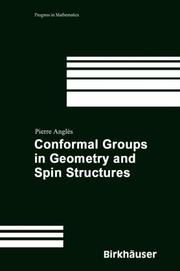
ISBN: 0817646434 9780817635121 0817635122 9780817646431 Year: 2008 Publisher: Boston, Massachusetts : Birkhäuser,
Abstract | Keywords | Export | Availability | Bookmark
 Loading...
Loading...Choose an application
- Reference Manager
- EndNote
- RefWorks (Direct export to RefWorks)
Conformal groups play a key role in geometry and spin structures. This book provides a self-contained overview of this important area of mathematical physics, beginning with its origins in the works of Cartan and Chevalley and progressing to recent research in spinors and conformal geometry. Key topics and features: * Focuses initially on the basics of Clifford algebras * Studies the spaces of spinors for some even Clifford algebras * Examines conformal spin geometry, beginning with an elementary study of the conformal group of the Euclidean plane * Treats covering groups of the conformal group of a regular pseudo-Euclidean space, including a section on the complex conformal group * Introduces conformal flat geometry and conformal spinoriality groups, followed by a systematic development of riemannian or pseudo-riemannian manifolds having a conformal spin structure * Discusses links between classical spin structures and conformal spin structures in the context of conformal connections * Examines pseudo-unitary spin structures and pseudo-unitary conformal spin structures using the Clifford algebra associated with the classical pseudo-unitary space * Ample exercises with many hints for solutions * Comprehensive bibliography and index This text is suitable for a course in mathematical physics at the advanced undergraduate and graduate levels. It will also benefit researchers as a reference text.
Group theory. --- Clifford algebras. --- Conformal geometry. --- Quaternions. --- Mathematical physics. --- Groups, Theory of --- Substitutions (Mathematics) --- Algebra --- Physical mathematics --- Physics --- Algebra, Universal --- Algebraic fields --- Curves --- Surfaces --- Numbers, Complex --- Vector analysis --- Circular geometry --- Geometry of inverse radii --- Inverse radii, Geometry of --- Inversion geometry --- Möbius geometry --- Geometry --- Geometric algebras --- Algebras, Linear --- Mathematics --- Geometry. --- Number theory. --- Algebra. --- Matrix theory. --- Mathematical Methods in Physics. --- Group Theory and Generalizations. --- Number Theory. --- Associative Rings and Algebras. --- Linear and Multilinear Algebras, Matrix Theory. --- Mathematical analysis --- Number study --- Numbers, Theory of --- Euclid's Elements --- Physics. --- Associative rings. --- Rings (Algebra). --- Algebraic rings --- Ring theory --- Rings (Algebra) --- Natural philosophy --- Philosophy, Natural --- Physical sciences --- Dynamics
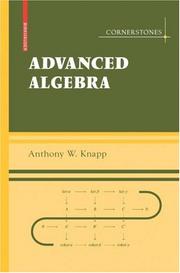
ISBN: 0817645225 0817646132 9780817645229 Year: 2008 Publisher: Boston, MA : Birkhäuser Boston : Imprint: Birkhäuser,
Abstract | Keywords | Export | Availability | Bookmark
 Loading...
Loading...Choose an application
- Reference Manager
- EndNote
- RefWorks (Direct export to RefWorks)
Basic Algebra and Advanced Algebra systematically develop concepts and tools in algebra that are vital to every mathematician, whether pure or applied, aspiring or established. Together, the two books give the reader a global view of algebra and its role in mathematics as a whole. Key topics and features of Advanced Algebra: *Topics build upon the linear algebra, group theory, factorization of ideals, structure of fields, Galois theory, and elementary theory of modules as developed in Basic Algebra *Chapters treat various topics in commutative and noncommutative algebra, providing introductions to the theory of associative algebras, homological algebra, algebraic number theory, and algebraic geometry *Sections in two chapters relate the theory to the subject of Gröbner bases, the foundation for handling systems of polynomial equations in computer applications *Text emphasizes connections between algebra and other branches of mathematics, particularly topology and complex analysis *Book carries on two prominent themes recurring in Basic Algebra: the analogy between integers and polynomials in one variable over a field, and the relationship between number theory and geometry *Many examples and hundreds of problems are included, along with hints or complete solutions for most of the problems *The exposition proceeds from the particular to the general, often providing examples well before a theory that incorporates them; it includes blocks of problems that illuminate aspects of the text and introduce additional topics Advanced Algebra presents its subject matter in a forward-looking way that takes into account the historical development of the subject. It is suitable as a text for the more advanced parts of a two-semester first-year graduate sequence in algebra. It requires of the reader only a familiarity with the topics developed in Basic Algebra.
Algebra. --- Algebraic number theory. --- Mathematics. --- Algebraic geometry. --- Category theory (Mathematics). --- Homological algebra. --- Field theory (Physics). --- Nonassociative rings. --- Rings (Algebra). --- Number theory. --- Non-associative Rings and Algebras. --- Field Theory and Polynomials. --- Algebraic Geometry. --- Number Theory. --- Category Theory, Homological Algebra. --- Mathematics --- Mathematical analysis --- Number theory --- Geometry, algebraic. --- Number study --- Numbers, Theory of --- Algebra --- Algebraic geometry --- Geometry --- Classical field theory --- Continuum physics --- Physics --- Continuum mechanics --- Algebraic rings --- Ring theory --- Algebraic fields --- Rings (Algebra) --- Homological algebra --- Algebra, Abstract --- Homology theory --- Category theory (Mathematics) --- Algebra, Homological --- Algebra, Universal --- Group theory --- Logic, Symbolic and mathematical --- Topology --- Functor theory --- Algebraic number theory
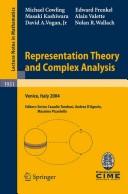

ISBN: 9783540768913 3540768912 3540768920 Year: 2008 Publisher: Berlin, Germany ; New York, New York : Springer-Verlag,
Abstract | Keywords | Export | Availability | Bookmark
 Loading...
Loading...Choose an application
- Reference Manager
- EndNote
- RefWorks (Direct export to RefWorks)
Six leading experts lecture on a wide spectrum of recent results on the subject of the title, providing both a solid reference and deep insights on current research activity. Michael Cowling presents a survey of various interactions between representation theory and harmonic analysis on semisimple groups and symmetric spaces. Alain Valette recalls the concept of amenability and shows how it is used in the proof of rigidity results for lattices of semisimple Lie groups. Edward Frenkel describes the geometric Langlands correspondence for complex algebraic curves, concentrating on the ramified case where a finite number of regular singular points is allowed. Masaki Kashiwara studies the relationship between the representation theory of real semisimple Lie groups and the geometry of the flag manifolds associated with the corresponding complex algebraic groups. David Vogan deals with the problem of getting unitary representations out of those arising from complex analysis, such as minimal globalizations realized on Dolbeault cohomology with compact support. Nolan Wallach illustrates how representation theory is related to quantum computing, focusing on the study of qubit entanglement.
Harmonic analysis --- Representations of groups --- Problèmes aux limites --- Représentations de groupes --- Congresses. --- Solutions numériques --- Congrès --- Operations Research --- Algebra --- Calculus --- Civil & Environmental Engineering --- Mathematics --- Physical Sciences & Mathematics --- Engineering & Applied Sciences --- Mathematics. --- Nonassociative rings. --- Rings (Algebra). --- Topological groups. --- Lie groups. --- Harmonic analysis. --- Functional analysis. --- Global analysis (Mathematics). --- Manifolds (Mathematics). --- Functions of complex variables. --- Functional Analysis. --- Topological Groups, Lie Groups. --- Abstract Harmonic Analysis. --- Non-associative Rings and Algebras. --- Global Analysis and Analysis on Manifolds. --- Several Complex Variables and Analytic Spaces. --- Complex variables --- Elliptic functions --- Functions of real variables --- Geometry, Differential --- Topology --- Analysis, Global (Mathematics) --- Differential topology --- Functions of complex variables --- Geometry, Algebraic --- Functional calculus --- Calculus of variations --- Functional equations --- Integral equations --- Analysis (Mathematics) --- Functions, Potential --- Potential functions --- Banach algebras --- Mathematical analysis --- Bessel functions --- Fourier series --- Harmonic functions --- Time-series analysis --- Groups, Lie --- Lie algebras --- Symmetric spaces --- Topological groups --- Groups, Topological --- Continuous groups --- Algebraic rings --- Ring theory --- Algebraic fields --- Rings (Algebra) --- Math --- Science --- Topological Groups. --- Algebra. --- Global analysis. --- Differential equations, partial. --- Global analysis (Mathematics) --- Partial differential equations
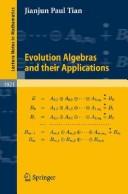
ISBN: 3540742832 3540742840 Year: 2008 Publisher: Berlin, Germany ; New York, New York : Springer,
Abstract | Keywords | Export | Availability | Bookmark
 Loading...
Loading...Choose an application
- Reference Manager
- EndNote
- RefWorks (Direct export to RefWorks)
Behind genetics and Markov chains, there is an intrinsic algebraic structure. It is defined as a type of new algebra: as evolution algebra. This concept lies between algebras and dynamical systems. Algebraically, evolution algebras are non-associative Banach algebras; dynamically, they represent discrete dynamical systems. Evolution algebras have many connections with other mathematical fields including graph theory, group theory, stochastic processes, dynamical systems, knot theory, 3-manifolds, and the study of the Ihara-Selberg zeta function. In this volume the foundation of evolution algebra theory and applications in non-Mendelian genetics and Markov chains is developed, with pointers to some further research topics.
Banach algebras --- Genetic algebras --- Nonassociative algebras --- Markov processes --- Phytophthora infestans --- Stochastic processes --- Algebra --- Calculus --- Mathematics --- Physical Sciences & Mathematics --- Genetics --- Banach algebras. --- Genetic algebras. --- Nonassociative algebras. --- Markov processes. --- Stochastic processes. --- Algebra. --- Genetics. --- Random processes --- Botrytis fallax --- Botrytis infestanus --- Botrytis solani --- Peronospora fintelmannii --- Peronospora infestans --- Peronospora trifurcata --- Phytophthora thalictri --- Potato late blight agent --- Potato late blight fungus --- Analysis, Markov --- Chains, Markov --- Markoff processes --- Markov analysis --- Markov chains --- Markov models --- Models, Markov --- Processes, Markov --- Algebras, Non-associative --- Algebras, Nonassociative --- Non-associative algebras --- Algebras, Genetic --- Algebras, Banach --- Banach rings --- Metric rings --- Normed rings --- Mathematics. --- Nonassociative rings. --- Rings (Algebra). --- Probabilities. --- Biomathematics. --- General Algebraic Systems. --- Non-associative Rings and Algebras. --- Probability Theory and Stochastic Processes. --- Mathematical and Computational Biology. --- Mathematical analysis --- Probability --- Statistical inference --- Combinations --- Chance --- Least squares --- Mathematical statistics --- Risk --- Biology --- Algebraic rings --- Ring theory --- Algebraic fields --- Rings (Algebra) --- Math --- Science --- Probabilities --- Phytophthora --- Algebra, Abstract --- Algebras, Linear --- Biomathematics --- Banach spaces --- Topological algebras --- Distribution (Probability theory. --- Distribution functions --- Frequency distribution --- Characteristic functions
| Listing 1 - 8 of 8 |
Sort by
|

 Search
Search Feedback
Feedback About UniCat
About UniCat  Help
Help News
News